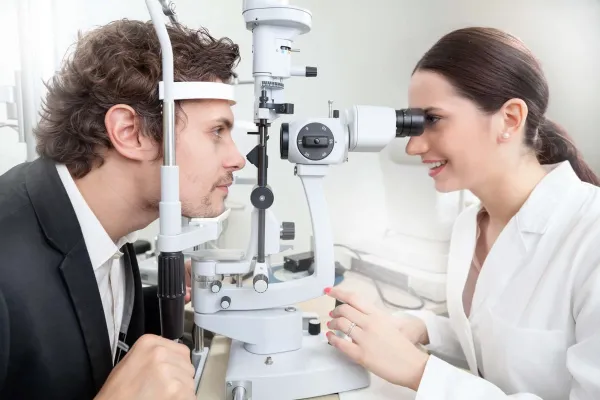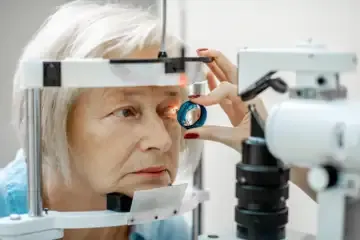What your eyes might be telling you about your overall health
admin | July 18, 2025 1:22 AM CST

Could our eyes reveal more than just vision problems? A new study suggests they might hold vital clues about heart health.
Published in the journal Cardiovascular Diabetology, the research indicates that a scan, which forms part of a routine eye test, could help predict a person's risk of heart attack or stroke within the next decade.
Conducted by researchers at the University of Dundee, the study used artificial intelligence to analyse digital retinal images from people with type 2 diabetes. The tool produced personalised predictions for who would go on to have "major cardiovascular events", like heart attacks or strokes, within a decade with 70% accuracy.
These findings raise a compelling question: what more could our eyes reveal about our overall health? We spoke with Dr Paramdeep Bilkhu, clinical adviser at The College of Optometrists, to find out…
How often should we get our eyes checked and why is it important?
"We advocate that everybody should get their eyes examined at least every two years," advises Bilkhu. "But it can be sooner than that, depending on your optometrist's recommendations. Even if you don't have any eye symptoms, it's really important to get them checked. During an eye examination, not only can we check vision and for eye conditions, we can also check for signs of other general health conditions."
Here are some health conditions that eye tests can detect signs of…
High blood pressure and diabetes
 "The two key areas that we can often pick up in an eye test are diabetes and high blood pressure, and that's by actually examining the eye internally," explains Bilkhu. "For diabetes, we can look after small areas of bleeding (diabetic retinopathy), and in high blood pressure that could be signs of the blood vessels having an abnormal configuration."
Many people are unaware they have high blood pressure or diabetes in the early stages, so regular eye check-ups are an effective way to detect these conditions early.
"Just by going for an eye examination - because optometrists can look inside the eye, look at the vessels, look at the structures - we can pick up any early signs without actually doing a blood test or taking a biopsy," says Bilkhu.
High cholesterol
Signs of high cholesterol typically only become visible in the eyes once the condition has reached a more advanced stage.
"If the cholesterol is raised for long periods, sometimes you can see a build-up of a cholesterol plaque which develops around the eyelids," highlights Bilkhu. "Also, sometimes there may also be some cholesterol deposits which are built up inside the vessels inside the eye, these are called a thrombus.
"If you see a thrombus inside the back of the eye that could be a very serious sign because it increases the risk of blocking the blood vessels which can lead to vision loss, and can also increase the risk of a stroke. So, if we do pick up these things, a patient will be referred to their GP or the emergency department if needed."
Autoimmune diseases
"The two key areas that we can often pick up in an eye test are diabetes and high blood pressure, and that's by actually examining the eye internally," explains Bilkhu. "For diabetes, we can look after small areas of bleeding (diabetic retinopathy), and in high blood pressure that could be signs of the blood vessels having an abnormal configuration."
Many people are unaware they have high blood pressure or diabetes in the early stages, so regular eye check-ups are an effective way to detect these conditions early.
"Just by going for an eye examination - because optometrists can look inside the eye, look at the vessels, look at the structures - we can pick up any early signs without actually doing a blood test or taking a biopsy," says Bilkhu.
High cholesterol
Signs of high cholesterol typically only become visible in the eyes once the condition has reached a more advanced stage.
"If the cholesterol is raised for long periods, sometimes you can see a build-up of a cholesterol plaque which develops around the eyelids," highlights Bilkhu. "Also, sometimes there may also be some cholesterol deposits which are built up inside the vessels inside the eye, these are called a thrombus.
"If you see a thrombus inside the back of the eye that could be a very serious sign because it increases the risk of blocking the blood vessels which can lead to vision loss, and can also increase the risk of a stroke. So, if we do pick up these things, a patient will be referred to their GP or the emergency department if needed."
Autoimmune diseases
 Certain eye conditions can be linked to autoimmune diseases.
"It's not uncommon for people to find that eye conditions such as iritis could be a sign of an autoimmune disease, like arthritis," says Bilkhu. "Iritis is an inflammatory condition which affects the iris and causes it to become quite swollen. It can be very painful and can actually cause long-term vision problems if not treated early.
"If there is a suspicion that it could be linked to a systemic disease, optometrists can't specify what the underlying condition is, but can suggest an association. Patients can then be referred for further testing usually with a rheumatologist or a GP, and then that will go to a specialist to decide what the problem is."Thyroid diseaseWhen thyroid disease progresses to later stages, it can be picked up in an eye sight test.
"Sometimes thyroid disease, specifically Graves' disease, can cause the eyes to bulge forward," says Bilkhu. "That's due to the swelling of the fat tissue behind the eye, and that can actually lead to exposure and dryness of the eyes. If we suspect a problem like this, then the patient will be referred to an appropriate specialist.
"However, this typically only occurs in the later stages of thyroid disease, so other symptoms are usually detected before it progresses to the point where it becomes noticeable during an eye exam."
Neurological conditions
Certain eye conditions can be linked to autoimmune diseases.
"It's not uncommon for people to find that eye conditions such as iritis could be a sign of an autoimmune disease, like arthritis," says Bilkhu. "Iritis is an inflammatory condition which affects the iris and causes it to become quite swollen. It can be very painful and can actually cause long-term vision problems if not treated early.
"If there is a suspicion that it could be linked to a systemic disease, optometrists can't specify what the underlying condition is, but can suggest an association. Patients can then be referred for further testing usually with a rheumatologist or a GP, and then that will go to a specialist to decide what the problem is."Thyroid diseaseWhen thyroid disease progresses to later stages, it can be picked up in an eye sight test.
"Sometimes thyroid disease, specifically Graves' disease, can cause the eyes to bulge forward," says Bilkhu. "That's due to the swelling of the fat tissue behind the eye, and that can actually lead to exposure and dryness of the eyes. If we suspect a problem like this, then the patient will be referred to an appropriate specialist.
"However, this typically only occurs in the later stages of thyroid disease, so other symptoms are usually detected before it progresses to the point where it becomes noticeable during an eye exam."
Neurological conditions
 Several neurological tests are carried out during the sight test which can indicate the function of the nervous system responsible for vision, explains Bilkhu.
"We look at the eye muscle movements, at the pupil's vision, we check the colour vision if need be, and then we can also check the optic nerve," says Bilkhu. "By examining those structures and undertaking relevant tests, sometimes the results could be indicative of an underlying neurological problem - potentially even a lesion along the brain or a lesion along the visual pathway."
If an optician or optometrist suspects this, the patient is referred to a specialist for further evaluation.
"In addition, although it's very rare, sometimes we can actually pick up a visual field defect that the patient may not be aware of following an eye examination, which could suggest an underlying pathology within the vision system in the brain," adds Bilkhu. "This could be the first time where something like a brain cancer could be picked up."
Several neurological tests are carried out during the sight test which can indicate the function of the nervous system responsible for vision, explains Bilkhu.
"We look at the eye muscle movements, at the pupil's vision, we check the colour vision if need be, and then we can also check the optic nerve," says Bilkhu. "By examining those structures and undertaking relevant tests, sometimes the results could be indicative of an underlying neurological problem - potentially even a lesion along the brain or a lesion along the visual pathway."
If an optician or optometrist suspects this, the patient is referred to a specialist for further evaluation.
"In addition, although it's very rare, sometimes we can actually pick up a visual field defect that the patient may not be aware of following an eye examination, which could suggest an underlying pathology within the vision system in the brain," adds Bilkhu. "This could be the first time where something like a brain cancer could be picked up."
 "The two key areas that we can often pick up in an eye test are diabetes and high blood pressure, and that's by actually examining the eye internally," explains Bilkhu. "For diabetes, we can look after small areas of bleeding (diabetic retinopathy), and in high blood pressure that could be signs of the blood vessels having an abnormal configuration."
Many people are unaware they have high blood pressure or diabetes in the early stages, so regular eye check-ups are an effective way to detect these conditions early.
"Just by going for an eye examination - because optometrists can look inside the eye, look at the vessels, look at the structures - we can pick up any early signs without actually doing a blood test or taking a biopsy," says Bilkhu.
High cholesterol
Signs of high cholesterol typically only become visible in the eyes once the condition has reached a more advanced stage.
"If the cholesterol is raised for long periods, sometimes you can see a build-up of a cholesterol plaque which develops around the eyelids," highlights Bilkhu. "Also, sometimes there may also be some cholesterol deposits which are built up inside the vessels inside the eye, these are called a thrombus.
"If you see a thrombus inside the back of the eye that could be a very serious sign because it increases the risk of blocking the blood vessels which can lead to vision loss, and can also increase the risk of a stroke. So, if we do pick up these things, a patient will be referred to their GP or the emergency department if needed."
Autoimmune diseases
"The two key areas that we can often pick up in an eye test are diabetes and high blood pressure, and that's by actually examining the eye internally," explains Bilkhu. "For diabetes, we can look after small areas of bleeding (diabetic retinopathy), and in high blood pressure that could be signs of the blood vessels having an abnormal configuration."
Many people are unaware they have high blood pressure or diabetes in the early stages, so regular eye check-ups are an effective way to detect these conditions early.
"Just by going for an eye examination - because optometrists can look inside the eye, look at the vessels, look at the structures - we can pick up any early signs without actually doing a blood test or taking a biopsy," says Bilkhu.
High cholesterol
Signs of high cholesterol typically only become visible in the eyes once the condition has reached a more advanced stage.
"If the cholesterol is raised for long periods, sometimes you can see a build-up of a cholesterol plaque which develops around the eyelids," highlights Bilkhu. "Also, sometimes there may also be some cholesterol deposits which are built up inside the vessels inside the eye, these are called a thrombus.
"If you see a thrombus inside the back of the eye that could be a very serious sign because it increases the risk of blocking the blood vessels which can lead to vision loss, and can also increase the risk of a stroke. So, if we do pick up these things, a patient will be referred to their GP or the emergency department if needed."
Autoimmune diseases
 Certain eye conditions can be linked to autoimmune diseases.
"It's not uncommon for people to find that eye conditions such as iritis could be a sign of an autoimmune disease, like arthritis," says Bilkhu. "Iritis is an inflammatory condition which affects the iris and causes it to become quite swollen. It can be very painful and can actually cause long-term vision problems if not treated early.
"If there is a suspicion that it could be linked to a systemic disease, optometrists can't specify what the underlying condition is, but can suggest an association. Patients can then be referred for further testing usually with a rheumatologist or a GP, and then that will go to a specialist to decide what the problem is."Thyroid diseaseWhen thyroid disease progresses to later stages, it can be picked up in an eye sight test.
"Sometimes thyroid disease, specifically Graves' disease, can cause the eyes to bulge forward," says Bilkhu. "That's due to the swelling of the fat tissue behind the eye, and that can actually lead to exposure and dryness of the eyes. If we suspect a problem like this, then the patient will be referred to an appropriate specialist.
"However, this typically only occurs in the later stages of thyroid disease, so other symptoms are usually detected before it progresses to the point where it becomes noticeable during an eye exam."
Neurological conditions
Certain eye conditions can be linked to autoimmune diseases.
"It's not uncommon for people to find that eye conditions such as iritis could be a sign of an autoimmune disease, like arthritis," says Bilkhu. "Iritis is an inflammatory condition which affects the iris and causes it to become quite swollen. It can be very painful and can actually cause long-term vision problems if not treated early.
"If there is a suspicion that it could be linked to a systemic disease, optometrists can't specify what the underlying condition is, but can suggest an association. Patients can then be referred for further testing usually with a rheumatologist or a GP, and then that will go to a specialist to decide what the problem is."Thyroid diseaseWhen thyroid disease progresses to later stages, it can be picked up in an eye sight test.
"Sometimes thyroid disease, specifically Graves' disease, can cause the eyes to bulge forward," says Bilkhu. "That's due to the swelling of the fat tissue behind the eye, and that can actually lead to exposure and dryness of the eyes. If we suspect a problem like this, then the patient will be referred to an appropriate specialist.
"However, this typically only occurs in the later stages of thyroid disease, so other symptoms are usually detected before it progresses to the point where it becomes noticeable during an eye exam."
Neurological conditions
 Several neurological tests are carried out during the sight test which can indicate the function of the nervous system responsible for vision, explains Bilkhu.
"We look at the eye muscle movements, at the pupil's vision, we check the colour vision if need be, and then we can also check the optic nerve," says Bilkhu. "By examining those structures and undertaking relevant tests, sometimes the results could be indicative of an underlying neurological problem - potentially even a lesion along the brain or a lesion along the visual pathway."
If an optician or optometrist suspects this, the patient is referred to a specialist for further evaluation.
"In addition, although it's very rare, sometimes we can actually pick up a visual field defect that the patient may not be aware of following an eye examination, which could suggest an underlying pathology within the vision system in the brain," adds Bilkhu. "This could be the first time where something like a brain cancer could be picked up."
Several neurological tests are carried out during the sight test which can indicate the function of the nervous system responsible for vision, explains Bilkhu.
"We look at the eye muscle movements, at the pupil's vision, we check the colour vision if need be, and then we can also check the optic nerve," says Bilkhu. "By examining those structures and undertaking relevant tests, sometimes the results could be indicative of an underlying neurological problem - potentially even a lesion along the brain or a lesion along the visual pathway."
If an optician or optometrist suspects this, the patient is referred to a specialist for further evaluation.
"In addition, although it's very rare, sometimes we can actually pick up a visual field defect that the patient may not be aware of following an eye examination, which could suggest an underlying pathology within the vision system in the brain," adds Bilkhu. "This could be the first time where something like a brain cancer could be picked up."
READ NEXT
-
Emma Watson banned from driving for 6 months over speeding

-
Do you also give Bubble Bath to your children? Go here and go …

-
Baseball’s Brent Rooker Responds To Fans Angry He Fed His Baby During A Game

-
Daily Tarot Horoscope Messages For Each Zodiac Sign On July 18, 2025

-
Which Is The Better Beginner Motorcycle?
